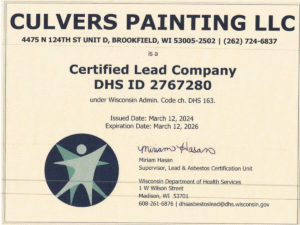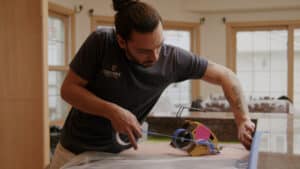Painting might look simple. Really, we know it does.
“I’ll do it myself” is often the go-to for new homeowners, until you’ve started painting and realize the brush marks, uneven texture, or wrong paint color are making a mess of your walls. Many homeowners make the same painting mistakes — from using the wrong roller nap to skipping primer — and those small missteps can ruin the finish fast.
At Culver’s Painting, we’ve spent years fixing these common painting mistakes and giving Milwaukee homeowners smooth walls, clean edges, and a finished painting job that actually lasts.
In this article, we’ll walk through the most common painting mistakes homeowners make, explain why they happen, and share how our professional painting crew handles each one with prep work, the right tools, and proven techniques for long-lasting results.
The Master Painting Mistakes List
Painting can look deceptively easy, but the difference between a professional finish and a weekend project often comes down to a few details. Each of these mistakes might seem small at first glance — but if ignored, they can lead to uneven color, peeling paint, or walls that never quite look right. Below, we break down each mistake, why it happens, and what you can do to avoid them (or better yet, how Culver’s Painting does it right the first time).
1. Skipping Proper Surface Prep
The mistake: Painting over dirt, grease, or flaking paint without the right prep work.
Why it happens: Homeowners often assume new paint will cover everything, but paint can’t stick to dust, grime, or glossy old layers.
Why it matters: Both oil-based paint and acrylic or latex paints need a clean, good surface to bond properly. Painting over residue or old paint is a big mistake that leads to peeling and bubbling.
How we fix it: We wash, sand, and prime every inch before applying a single light coat. That prep work helps every layer of paint adhere smoothly for a flawless, lasting finish.
2. Using the Wrong Paint
The mistake: Choosing latex or cheap acrylic on trim or doors.
Why it happens: Many homeowners grab what’s cheapest or easiest to find, not realizing different surfaces demand specific formulas.
Why it matters: The wrong paint dries too fast and chips easily, especially in high-touch areas like doors and baseboards.
How we fix it: We use high-quality oil-based primer and then industry-leading Sherwin-Williams paints that resist wear, clean easily, and maintain that rich, even sheen for years.
3. Using Too Much Paint or Too Little Paint
The mistake: Loading the brush or roller with too much paint or not enough paint.
Why it happens: It’s easy to think more paint equals better coverage — or that less paint will stretch your budget further.
Why it matters: Too much paint causes drips, runs, and sagging, while too little paint leaves thin spots that require extra coats.
How we fix it: Our spray technique applies a perfect, even layer across every surface — no puddles, no streaks, no wasted gallons.
4. Skipping Primer
The mistake: Skipping primer or trusting a “paint-and-primer” combo on bare surfaces.
Why it happens: People underestimate how important primer is for adhesion and coverage.
Why it matters: Without primer, the finish can look blotchy and uneven. Stains and old colors may even bleed through.
How we fix it: We always start with oil-based primer matched to the surface type — whether it’s wood, drywall, or metal — so the final coat sticks perfectly and the color comes out even and true.
5. Working in the Wrong Conditions
The mistake: Painting when it’s too humid, too cold, or directly in the sun.
Why it happens: Most DIY painters don’t realize temperature and humidity affect how paint dries and bonds.
Why it matters: Oil-based paint takes longer to dry, and in poor conditions it can wrinkle, crack, or fail to level evenly.
How we fix it: We plan every painting project around the forecast and adjust airflow, shade, and timing to make sure every coat cures completely dry and smooth.

6. Ignoring the Right Tools
The mistake: Using a brush or roller that’s too rough or the wrong roller nap for the surface.
Why it happens: It’s tempting to grab whatever brush is on sale, but tool choice makes all the difference.
Why it matters: Cheap tools leave brush marks, uneven edges, and more texture than you want on smooth walls.
How we fix it: We use professional sprayers, rollers, and fine-bristle brushes designed for oil-based coatings. The result? Clean lines, even coats, and zero streaks.
7. Forgetting Painter’s Tape and Drop Cloths
The mistake: Skipping painter’s tape or drop cloths to save time.
Why it happens: DIYers often rush, assuming they can paint carefully without masking or covering anything.
Why it matters: Wet paint splatters easily, and once it dries on floors or furniture, it’s hard to remove.
How we fix it: We tape every edge, cover furniture, remove outlet and switch covers, and protect floors thoroughly so the only thing that gets painted is what’s meant to.
8. Painting the Same Area Over and Over
The mistake: Going back over wet paint to fix a spot.
Why it happens: It’s natural to want perfection, but repeatedly brushing wet paint actually ruins the finish.
Why it matters: Overworking wet paint causes streaks, uneven sheen, and visible lap marks.
How we fix it: We spray in smooth, overlapping passes, maintaining a wet edge so the finish self-levels perfectly without brush lines or dull patches.
9. Rushing the Second Coat
The mistake: Not waiting for the first coat to be completely dry.
Why it happens: Homeowners get impatient — they want to finish fast and see the results right away.
Why it matters: If paint hasn’t cured, a second coat can pull up the first, leaving patches or ridges.
How we fix it: We wait until each layer is fully dry before reapplying. It takes more time, but the payoff is a finish that’s even, glossy, and durable.
10. Not Calling a Professional Painter Sooner
The mistake: Thinking a DIY paint job will look the same as a pro’s.
Why it happens: Painting seems simple — until it isn’t.
Why it matters: Small painting mistakes turn into costly fixes when walls need to be redone.
How we fix it: Our crew handles every step — from prep work and priming to spraying and cleanup — for a result that’s clean, consistent, and built to last. You’ll get vibrant color, smooth walls, and flawless edges that make your home shine.
Ready for a Flawless Finish Near You?
If you’re searching for “house painters near me” or wondering how to fix common painting mistakes, Culver’s Painting is ready to help. From exterior prep work and painting to interior trim painting, our Milwaukee painters know how much paint to use, how long to let it cure, and how to leave you with smooth, durable walls that shine.
Request your free estimate today and see why so many homeowners trust Culver’s Painting for a flawless, lasting finish.





